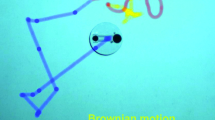Abstract
Mycoplasma sp. nov. strain 163K, the gliding microorganism isolated from the gills of a tench (Tinca tinca L.), is capable of chemotaxis, being attracted to sugars, amino acids, and mucus. The chemotactic behavior of the organisms was microscopically investigated and documented by long-time exposure photomicrographs providing motility tracks. In diffusion-generated concentration gradients of chemoattractive substances, the random motion of the mycoplasmas was strongly biased in the direction of increasing attractant concentrations.
Similar content being viewed by others
Literature Cited
Adler J (1966) Chemotaxis in bacteria. Science 153:708–716
Adler J (1975) Chemotaxis in bacteria. Annu Rev Biochem 44:341–356
Daniels MJ, Longland JM (1984) Chemotactic behaviour of spiroplasmas. Curr Microbiol 10:191–194
Daniels MJ, Longland JM, Gilbart J (1980) Aspects of motility and chemotaxis in spiroplasmas. J Gen Microbiol 118:429–436
Davis RE, Worley JF (1973) Spiroplasma: motile, helical microorganism associated with corn stunt disease. Phytopathology 63:403–408
Dworkin M, Eide D (1983)Myxococcus xanthus does not respond chemotactically to moderate concentration gradients. J Bacteriol 154:437–442
Fluegel W (1963) Fruiting chemotaxis inMyxococcus fulvus (Myxobacteria). Proc Minn Acad Sci 32:120–123
Ho J, McCurdy HD (1979) Demonstration of positive chemotaxis to cyclic GMP and 5′AMP inMyxococcus xanthus by means of a simple apparatus for generating practically stable concentration gradients. Can J Microbiol 25:1214–1218
Kirchhoff H, Rosengarten R (1984) Isolation of a motile mycoplasma from fish. J Gen Microbiol 130:2439–2445
Kirchhoff H, Rosengarten R, Lotz W, Fischer M, Lopatta D (1984) Flask-shaped mycoplasmas: properties and pathogenicity for man and animals. Isr J Med Sci 20:848–853
Macnab RM, Koshland DE Jr (1972) The gradient-sensing mechanism in bacterial chemotaxis. Proc Natl Acad Sci USA 69:2509–2512
McVittie A, Zahler SA (1962) Chemotaxis in myxococcus. Nature (Lond) 194:1299–1300
Radestock U, Bredt W (1977) Motility ofMycoplasma pneumoniae. J Bacteriol 129:1495–1501
Vaituzis Z, Doetsch RN (1969) Motility tracks: technique for quantitative study of bacterial movement. Appl Microbiol 17:584–588
Author information
Authors and Affiliations
Rights and permissions
About this article
Cite this article
Kirchhoff, H., Boldt, U., Rosengarten, R. et al. Chemotactic response of a gliding mycoplasma. Current Microbiology 15, 57–60 (1987). https://doi.org/10.1007/BF01577215
Issue Date:
DOI: https://doi.org/10.1007/BF01577215




